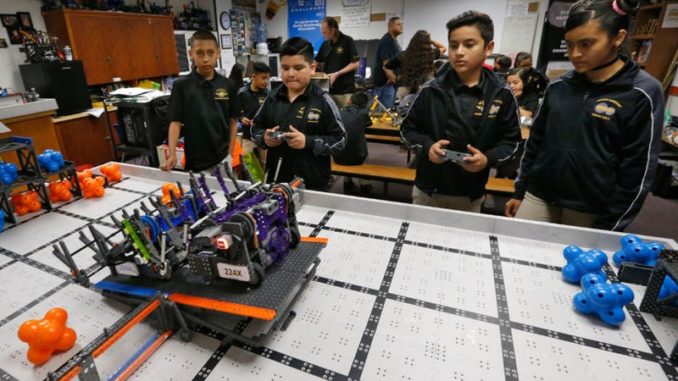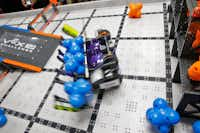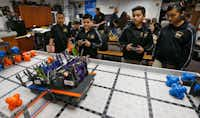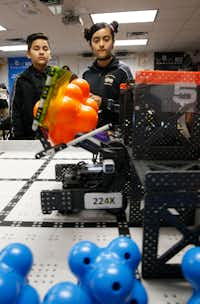
Hector Martinez drives, builds and programs robots. And he is only in fifth grade. Shy and soft-spoken, Hector says he wants to work in robotics when he grows up.
He is not alone in this aspiration at Winnetka Elementary School. The Oak Cliff campus has two teams that competed in the world robotics championship in Kentucky this spring. The Dallas ISD school came away with second place in teamwork in the technology division, where Winnetka’s two squads were competing with students from 31 nations, including China and Russia. Earlier this year, the teams won first place in teamwork at the national competition. And this spring they won first place in teamwork at the state level.
Those awards were not the school’s first triumph in robotics. A Winnetka team finished at the top in programming at the nationals last year and took first place in programming and overall excellence in the state competition.
What is happening at this Dallas school district campus is encouraging as well as instructive. One of the economy’s biggest challenges is making the forces of automation and globalization work for more people. That is especially important as we debate more decent-paying jobs, the kind that expand the middle class.

Fifth-grader Keyri Fernandez was part of the award-winning teams both years. On a recent visit to her campus, she described how she uses computers to program robots. That includes creating the program to drive them. Keyri is the master builder of the robots, where she and her fellow competitors constructed a Lego-looking machine with axles, motors, sensors and other features.
Abelino Graciano was on the team both years, too. A driver and builder, he talks about using these skills in the future to operate drones and move things around faster. “This can make you grow to be an engineer,” he explained in the robotics classroom that he and his teammates use, often coming in at lunch to work on their projects.
Collaboration is a big part of their learning curve. One part of their competition requires being able to take an assignment, work together on an answer, and show how their strategy works — all within a one-minute game. Perhaps that is why the word “we” comes up frequently with these students. They must put their brains together, or else they won’t create a fast, workable solution.
The “we” word certainly comes up as Jocelyn Rodriguez describes the journal Winnetka’s robotics squads had to create. The fifth-grader shows page after page of models, strategies and science-technology-engineering-math (STEM) projects, which include a robot that Domino’s is using to deliver pizzas in some cities.
Like Jocelyn, Dailyn Ochoa is one of 16 girls on Winnetka’s 23-person robotics roster. She researched a STEM project that shows how robotics helps people with disabilities. She and her team designed a robot that would allow a person with a disability to command the robot to take them to the grocery store, the hospital or on most any other errand.

These students are led by teachers Jeremy Williams and Rodolfo Estrada. They speak passionately about their students’ work, including the fact they learned coding as early as first grade. These instructors have made learning both rigorous and relevant for their students.
“This is an opportunity for them to innovate with their ideas,” Estrada says. “They get to learn science, engineering and math all at once, plus it is fun.”
“Fun” is a point that Williams emphasizes, too. “When kids see learning is fun,” he notes, “they are not closed off. They are more dedicated to learning.”
The automation challenge starts as far back as elementary school. As Winnetka’s robotics teams show, we then begin acquiring the abilities and skills to eventually lead the forces of globalization and automation, not let them hold us hostage.
Almost surely, most parents would rather their children grow up and manage robots than have the robots manage them. In other words, be in charge of emerging technologies so students kids can adapt as technologies reshape the economy.
For parents, the logical question is, are their children receiving an education that will allow them to take advantage of the forces of technology? The answer is complicated, but it starts with knowing whether their children are reading and doing math at the proper grade level. If they are not, what should happen? Does the school need better supports? Does it need a better leader? Does it need more effective instruction?

Why families need to know
The answers to those types of questions are tied up with states, schools and districts enacting the right education policies.
Some changes were made to the system in the just-ended Texas legislative session, such as trimming the number of categories used to grade schools and districts. But, fortunately, the system was not gutted.
Parents still will be able to have a more detailed assessment of their child’s school beyond the current met-standard/did-not-meet-standard rankings. Instead of that pass/fail system, schools will receive grades based on how well they help students achieve at the right grade level, how much progress the schools are making in key subjects, and the degree to which they are closing education gaps between low- and high-performers.
For some schools and districts the data will look good. For others, it will not. But at least parents can have a better sense of where their child’s district and school stand. Then, parents can start asking what can be done to enhance or improve.
Consider also the policy debate over STAAR exams. To put it mildly, we hear plenty of complaints about those state tests. But without the same independent exam given to all students across Texas, the state would have no way of gathering comparable data on schools and districts. It’s one thing to tweak and improve the tests, but doing away with some of them, as a group of legislators and educators unsuccessfully tried to do this year, would return us to the days when it was fine to let some schools slide by, especially in poor, minority communities.
Equally important, data from independent, objective exams helps classrooms receive supports so students can learn at the right grade level in subjects like reading, math and science. If schools know where students are going off-track, they can apply strategies that research shows can work.

The speed of change
We certainly know that the forces of automation are not going to slow down. They are only going to speed up.
Budweiser recently tested a driverless truck, sending it 120 miles to deliver beer to a warehouse. (Like the Clydesdales, it delivered the goods.) Robots are being used for some types of surgery in out-patient clinics. And, as we saw in Dallas last summer when police used a robot to end the downtown ambush, police can use robots in situations that otherwise could put an officer’s life in jeopardy.
Beyond these anecdotes, a startling 2013 Oxford University study highlights the impact of automation, including robotics, on U.S. employment. The report shows that about half of U.S. jobs are at risk of being performed by computers over the next few decades.
We could freak out, but the Oxford study was clear that occupations that require “creative intelligence” are not at risk. That means jobs where people are prized for coming up with novel, valuable ideas, much like the Winnetka students are doing with their robots. So, let’s think instead about equipping more students like those at Winnetka Elementary with the critical thinking skills that will be needed to manage — and work with — robots.
Writing in a recent edition of The New York Times Magazine, Kim Tingley reported on how robots worked alongside employees at a Minnesota company that makes molds for complex medical products. The revolutionary aspect of this workplace, she explained, was not the speed of the robots but the degree to which they collaborated with other workers. As she put it, we need to prepare for a future “in which robots interact with humans in increasingly sophisticated ways, and one that — thanks to rapid advances in computing and mechanical engineering — is coming, and coming soon.”
Winnetka’s robotics students are being prepared for that fast-coming future. The extent that other students are, too, starts with knowing whether they and their schools are succeeding. Believe it or not, mastering the forces of automation starts as early as elementary school.
William McKenzie is editor of The Catalyst: A Journal of Ideas from the Bush Institute and has been part of an accountability policy council set up by Texas Education Commissioner Mike Morath to advise him on the implementation of the A-F system. Email: [email protected]



